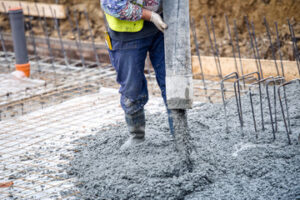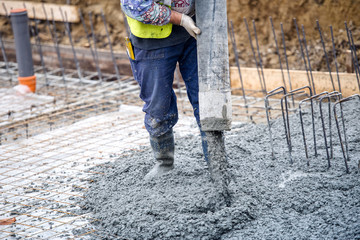Concrete repair can be a challenging task. Many factors must be considered when selecting a factual repair material for an application. For example, it’s important to consider dimensional characteristics, drying shrinkage, thermal stress, and freeze-thaw resistance. Additionally, some materials require a certain curing regime. Others may need protection from water exposure until they achieve their desired strength. Visit https://www.concreterepairdallas.com/ for more details.

The successful installation of a concrete repair material relies first upon the mechanical bond between the surface and substrate. The chemical bond between the materials follows this. The concrete must be structurally sound and free of contaminants that impede adhesion, such as oil, grease, loose dirt, dust, or other foreign matter.
Generally, a high percentage of topical materials, including sealers, coatings, and overlays, fail because the substrate was not properly prepared before application. That includes saturating the concrete with potable water to reach an SSD (saturated but surface dry) condition.
A critical step in preparing concrete for repair is to roughen the existing surface. That is achieved by either abrasive blasting or chemical methods. The aim is to open pores and light cracks, expose aggregates, and provide a profile resembling 40-grit sandpaper (ICRI CSP 3) or higher. The concrete must also be free of loose contaminates, form release, and curing compounds.
The perimeter of the repair area must be clearly defined using a saw cut or other means. That is to prevent the application of a repair material in the regions that do not support it. That will help avoid future material failures because of internal stress generated during curing.
If a structural repair is performed, certified shoring should be provided to support the structure. It is also necessary to remove the damaged concrete if its structural condition has been compromised by spalling or serious cracking.
Finally, before any repair, all exposed rebar should be cleaned of corrosion products to NACE 3 or SSPC SP6 standards. The proper amount of clearance must be maintained for the rebar to allow for cleaning, encasement, and bonding.
It is also important to note that most epoxy or other polymer repair materials expand and contract about 5-10 times more than concrete or steel during temperature changes. That is because they are filled with inorganic solids. For this reason, installing these materials in multiple lifts is often necessary to avoid excessive shrinkage stresses and premature cracking of the repair.
Concrete repair is most successful when the bond between the new and existing concrete is strong. This bond is mainly developed through surface preparation, but the choice of repair material and proper execution also play an important role. Many repairs fail due to the poor bond between the original and repaired concrete. The most common reason for this is that the contractor used a different cement than the one specified in the concrete mix design, or they needed to follow the mixing instructions.
The first step in preparing for concrete repair is thoroughly cleaning the area. Contractors should use a broom and brush to remove any loose dirt, gravel, or other debris from the site that will be repaired. They may then spray the area with water. Getting the area dry before starting is vital because moisture will rob concrete of its strength.
After the area is clean, contractors should mix their concrete for repair. They should use good quality Portland cement, but it is also possible to find some that contain polymers and other additives for improved performance. In any case, the adhesive should be mixed with water to form a paste. Then, a thin coat is applied to the damaged area. This scratch coat is not intended to be set, but it will help the additional concrete to adhere to the old concrete.
Some contractors use moisture-tolerant epoxies for crack injection, but these materials work better in wet conditions. They can also cause moisture to accumulate in the crack, leading to corrosion of reinforcing steel and other problems.
Other repair methods include using a chemical stabilizer for wet concrete or a foam solution like PolyLevel. PolyLevel solves the underlying problem of soil not being compacted properly by injecting a small amount of polyurethane through pencil-eraser-sized ports in the sinking slab. It is quick, non-invasive, aesthetically pleasing, durable, and permanent. It is also a great alternative to a traditional concrete lift, which is messy and chaotic and requires drilling large holes for the injection.
The proper curing of concrete is essential for its quality and durability. It begins immediately after placing and finishing and involves maintaining desired moisture and temperature conditions at the surface and within its depth.
Concrete repair materials must have low shrinkage to bond well with the original factual matrix. That can be achieved by incorporating additives into the mix. For example, QUIKRETE is now providing its repair products with polymers, leading to better bond strength and durability.
Proper site preparation is also important. Removing any vegetation, debris, or other materials that may hinder the bond between the repaired area and the original concrete is necessary. That is especially true for repairing existing slabs damaged by freeze/thaw cycles or ground movement, which can cause cracking and debonding.
Contractors should also ensure they use the right type of concrete for each project. For example, if a structural concrete slab has been damaged by water, it must be repaired with a waterproofing material. In addition, contractors should test the hardness of the concrete by performing a scratch test before beginning the repairs. That will allow them to choose the best concrete patching method.
Another factor in determining the appropriate repair method is understanding the root causes of the damage. If a foundation settlement has damaged the concrete, it will likely continue to settle and cannot be repaired by patching alone. In these cases, a concrete underpinning system should be installed.
For smaller concrete surfaces, contractors can use a membrane curing technique to protect the concrete from the elements and prevent excessive water loss. This technique uses a liquid membrane-forming compound applied to the concrete surface, which acts as a barrier to water loss and helps the concrete maintain its moisture content for an extended period.
For larger concrete projects, contractors can use a curing blanket or plastic sheeting to protect the concrete from rain and other elements. That can help the concrete retain its moisture longer, allowing it maximum strength and durability. Finally, contractors can use a cure and seal to protect the concrete from weathering, chemical damage, and other forms of damage.
Concrete is a popular material for walkways and driveways, but like most materials it needs to be maintained properly. It also shows signs of wear and tear, such as cracks and holes. Many homeowners may believe it’s time to replace their concrete, but repair is often better.
The first step in any concrete repair is determining what the problem is. There are two main types of damage: structural and non-structural. For structural repairs, a specialized process called epoxy injection can be used. This method works by injecting an epoxy into the cracks and welding them together to form a monolithic structure. However, this type of repair should only be attempted with a professional engineer.
A urethane sealant can be used for non-structural repairs. That is an easy-to-use, cost-effective method of repairing concrete cracks. This sealant can be placed directly into the cracks and is injected with a pressure pump. However, this method does not create a strong structural bond and is only recommended for active trials that are not moving.
Another important factor is surface prep. Contractors should ensure the concrete is free of dirt, oil, or other material that will prevent the new concrete from adhering to it. Using the right material for the job is also important. The wrong product can cause failure in a short amount of time. For this reason, ICRI recommends contractors consult with the product manufacturer before starting the project.
Lastly, contractors should test the concrete for its psi before beginning a repair. That will help ensure the new repair has enough strength to withstand the loads and stress it will be subjected to. The concrete must be cured and placed under a load for about a month to perform this test.
Although concrete repair has its advantages, it also hurts the environment. Increased substantial repair activities lead to depletion of natural resources, waste generation, and carbon emissions. Engineers can help design eco-efficient concrete repair systems that achieve specified performance levels with a minimum environmental impact.


